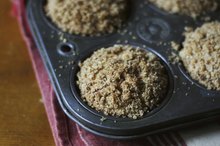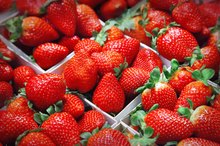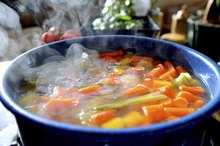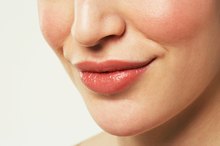Foods to Avoid for Pemphigus
Pemphigus is an autoimmune disease that is most prevalent in adults over the age of 50. Symptoms include blistering throughout the mucous membranes of the body. Blistering most often occurs in the mouth and throat, but can also occur in the nose, around the eyes, and in the membranes of the genital region. Immunosuppressant and antibiotic drugs are used to manage the condition and to prevent infection. If you have been diagnosed with pemphigus, speak to your doctor about your diet. Certain foods can aggravate your condition.
Acidic and Spicy Foods
Acidic and spicy foods should be avoided when you have an outbreak of pemphigus blisters, because the acids, papain or other heat-inducing chemicals in these foods can be very painful when the food comes in contact with your oral lesions. Citrus fruits and juices, tomato products, hot peppers, salsa, curries and other spicy items are just some of the foods you may want to avoid during this time.
Onion and Garlic Family
Foods to Avoid With Esophagitis
Learn More
The International Pemphigus and Pemphigoid Foundation reports that foods in the onion and garlic family, including chives, leeks and shallots, may actually contribute to pemphigus in some cases 1. Studies reported in the November 1998 issues of "Archives in Dermatology" examined foods that contain a compound called thiols, a chemical that is also present in medications found to induce pemphigus. Results of the studies showed that when people who had blistering of the skin consistent with pemphigus eliminated these vegetables from their diets, they experienced a decrease in symptoms. Whereupon when onion, garlic and related foods were reintroduced, the skin condition worsened.
- The International Pemphigus and Pemphigoid Foundation reports that foods in the onion and garlic family, including chives, leeks and shallots, may actually contribute to pemphigus in some cases 1.
- Studies reported in the November 1998 issues of "Archives in Dermatology" examined foods that contain a compound called thiols, a chemical that is also present in medications found to induce pemphigus.
Tannins
Tannins are a substance found in a wide variety of dark-colored foods and drinks, including red wine, cola soft drinks, berries, grapes, eggplant, as well as in bananas, avocados and apples and pears. A medication called penicillamine also contains tannins and can produce pemphigus-like symptoms in some people, according to the "Archives of Dermatology." You may not need to avoid all foods that contain tannins depending on your individual condition and the tannin level of the foods. Consult your doctor for further instruction about limiting your tannin intake in relation to pemphigus.
- Tannins are a substance found in a wide variety of dark-colored foods and drinks, including red wine, cola soft drinks, berries, grapes, eggplant, as well as in bananas, avocados and apples and pears.
- A medication called penicillamine also contains tannins and can produce pemphigus-like symptoms in some people, according to the "Archives of Dermatology."
Phenols
Colitis Diet Foods to Avoid
Learn More
Phenol is another term for carbolic acid, a compound that is naturally occurring in some foods and added to others in synthetic form. Artificial sweeteners, as well as tomatoes, potatoes and mangoes contain pinene, another type of phenol, and can worsen pemphigus symptoms. Not all foods will affect you the same way; keep an elimination journal as you avoid certain foods and determine which foods are best to stop eating when your disease flares.
- Phenol is another term for carbolic acid, a compound that is naturally occurring in some foods and added to others in synthetic form.
- Artificial sweeteners, as well as tomatoes, potatoes and mangoes contain pinene, another type of phenol, and can worsen pemphigus symptoms.
Hard and Crusty Foods
Foods that are hard, sharp or crusty, such as potato chips or crusty breads, should be avoided during a period of active blistering. The reason for avoidance in this case is to make you feel more comfortable and reduce the risk of injuring yourself further. Sharp-edged foods that scrape against your mouth and throat as you eat can tear blisters and other healing erosions open, leaving you in more pain and susceptible to infection.
Related Articles
References
- International Pemphigus and Pemphigoid Foundation; Are There Foods That I Should Avoid?; Sarah Brenner, et al.; 2011
- Dermnet NZ; Pemphigus Vulgaris; Vanessa Ngan; February 2010
- International Pemphigus and Pemphigold Foundation. Pemphigus.
- Arpita R, Monica A, Venkatesh N, Atul S, Varun M. Oral Pemphigus Vulgaris: Case Report. Ethiop J Health Sci. 2015;25(4):367-72.
- National Institute of Arthritis and Musculoskeletal and Skin Diseases. Pemphigus.
- Vodo D, Sarig O, Sprecher E. The Genetics of Pemphigus Vulgaris. Front Med (Lausanne). 2018;5:226. doi:10.3389/fmed.2018.00226
- Gregoriou S, Efthymiou O, Stefanaki C, Rigopoulos D. Management of pemphigus vulgaris: challenges and solutions. Clin Cosmet Investig Dermatol. 2015;8:521-7. doi:10.2147/CCID.S75908
- Abréu-vélez AM, Reason IJ, Howard MS, Roselino AM. Endemic pemphigus foliaceus over a century: Part I. N Am J Med Sci. 2010;2(2):51-9.
- Kasperkiewicz M, Ellebrecht CT, Takahashi H, et al. Pemphigus. Nat Rev Dis Primers. 2017;3:17026. doi:10.1038/nrdp.2017.26
- Kridan, K.; Zelber-Sagi, S.; and Bergman, R. Mortality and cause of death in patients with pemphigus. Acta Derm Venereol. 2017; 97:xx-xx.
- Kwan, H.; Kwon, I.; Chung, J. et al. Pemphigus foliaceus associated with psoriasis during the course of narrow-band UVB therapy: A simple coincidence? Ann Dermatol. 2011;23(Suppl 3): S281-S284. doi:10.5021/ad.2011.23.S3.S281.
- Yamagami, J. Recent advances in the understanding and treatment of pemphigus and pemphigoid. F1000Res. 2018;7:F1000 Faculty Rev-1360. doi:10.12688/f1000research.14474.1.
Writer Bio
Erica Roth has been a writer since 2007. She is a member of the Society of Professional Journalists and was a college reference librarian for eight years. Roth earned a Bachelor of Arts in French literature from Brandeis University and Master of Library Science from Simmons College Graduate School of Library and Information Science. Her articles appear on various websites.









